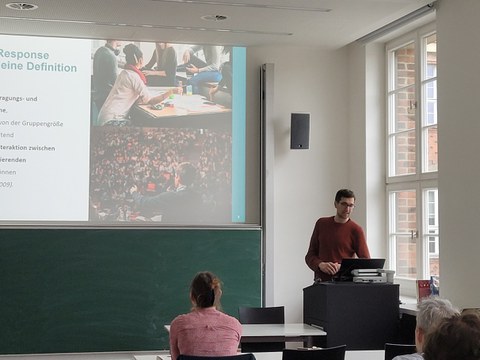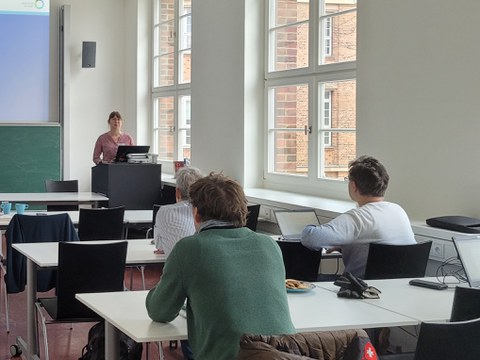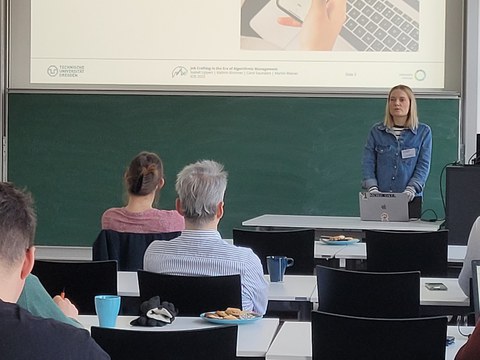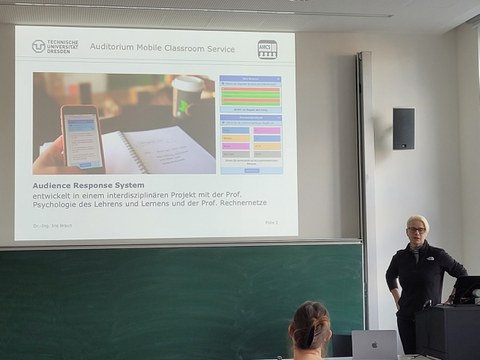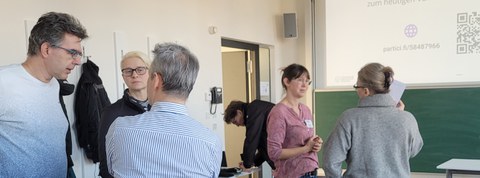Review: ARS
The sixth networking and digital teaching workshop on activating teaching methods and audience response systems (ARS) took place on February 7, 2025 under the moderation of Maja Liebscher.
Table of contents
- More interaction in seminars and lectures with ARS: application scenarios and methods
- Participating instead of listening: Activating teaching methods and ARS in practice
- Activate digitally: Sli.do as a tool for large and small courses
- Auditorium Mobile Classroom Service - a complex ARS and its didactic applications
More interaction in seminars and lectures with ARS: application scenarios and methods
Standing in for Josefine Marquardt from Hochschuldidaktik Sachsen (HDS), Konstantin Thieme gave an introduction to audience response systems and spoke about the purposes and possibilities of didactic integration.
To the slide set:
The most important statements:
- ARS are digital tools that enable interactive answer input, evaluation and display for different types of questions in the course.
- Teachers can use them to control the course, check the level of knowledge, identify comprehension problems, obtain feedback, reflect on content and much more.
- ARS can be used well, for example, in peer instruction and think-pair-share methods.
Participating instead of listening: Activating teaching methods and ARS in practice
Dr. Katja Richter from the Chair of Photogrammetry reported on her diverse use of methods in her courses. Thanks to the many different methods she offers students, she has received good feedback and even won a teaching award.
To the slide set:
Katja Richter: Activating teaching methods and ARS
The most important statements:
-
The aim in courses is for students not only to listen, but also to apply their acquired knowledge directly, thereby increasing learning success. At the same time, attention is increased and students are occasionally activated.
-
Depending on the number of students and semesters, different methods can be used. In mass courses in the lower semesters, for example, inhibitions should be reduced so that low-threshold methods have to be used. At least one activation was built into each course.
-
Obtaining expectations with the evaluation target: the students' expectations are asked at the beginning of a course series in order to be able to better address the desired content. In this way, the interests of the students can be addressed where possible. The Oncoo tool is suitable for this.
-
Tying in with real life: With the help of the quiz tool arsnova, students can be asked about parallels between the subject content and their everyday lives, for example analogies and what similarities and differences there are to the subject topics. Arsnova works without registration and the questions are created in a short time.
-
Obtaining feedback on the lecture: With the help of question tools such as arsnova, students can be asked about the course that has just taken place. The responses are often very positive. In addition, students' concentration does not wane so quickly if the lectures are interactive and varied. Practical participation is particularly appreciated.
- Reactivate existing knowledge: With One Minute Paper, knowledge from school or previous modules can be recalled. Students have to write down everything they already know within one minute. They are then told what they should know and therefore need to catch up on if they do not have the knowledge.
- Reviewing the last learning material: Freewriting can be used to review the learning material from the last lecture. The students have to write down everything they remember within a given time. The flow of writing must not be interrupted, spelling and grammar are not important, no one else will read the text later.
- Identify learning material: Students can be asked to come up with exam questions themselves. The questions can then be swapped and answered. As an incentive, particularly good questions can be included in self-tests or the exam itself.
- Promote deeper understanding
- with Think Pair Share: A specific task is first worked on individually, then in pairs and finally in plenary. This method works well with up to 40 people.
- with research, data research and visualization: for example with an online pinboard such as Padlet. Research and, if necessary, data evaluation by students, entries in the Padlet. Can be exported as a PDF and used for further lectures.
- with the creation of a display board, for example digitally supported. This can be an info-graphic, an overview or a mind map. Suitable for lecture content, research and exam preparation.
Activate digitally: Sli.do as a tool for large and small courses
Isabell Lippert from the Chair of Business Information Systems, in particular Business Engineering, presented the tool Sli.do, which can be used to activate students to participate in small and large courses.
To the slide set:
Isabell Lippert: Activate digitally - Sli.do as a tool for large and small courses
The most important statements:
-
Many students do not participate in large and small courses because they are afraid of embarrassment and do not dare to do so. Internationalization can also create language barriers. Often only the teacher and the same few students interact with each other.
-
Sli.do works in a similar way to Mentimeter. It can be seamlessly integrated into PowerPoint as an add-in, so there is no need to switch windows. It is therefore also suitable for hybrid events. Registration by the teacher or a chair is required. Unlimited use costs 17 dollars per month.
-
Various interaction options are available, which can be added in the PowerPoint add-in:
- Joining Slide: includes a QR code so students can use their cell phones to get to the question pages.
- Check in with names to check the students' reaction. Sometimes students choose strange names. However, anonymity is important to reduce barriers and fears when participating.
- Audience Q&A for answering questions. MC questions are easy to insert. A short quiz at the beginning of each exercise, for example, is suitable for engaging students in conversation afterwards.
- Leaderboard for displaying a ranking of the best five participants.
- Open text for comments, feedback or open questions. These answers are listed on the slide.
- Rating suitable for the end of a course to receive low-threshold feedback from 1 to 5 stars.
The answers are always displayed, but not saved in the slide set. -
Sometimes free texts are misused by funny text contributions, this should be skillfully ignored or, if necessary, the students should be confronted with their misconduct.
-
The students show what they are capable of with their interactions. Nevertheless, you still have control over how much you allow and incorporate into the course. This allows you to determine how long students should use their cell phones and when they should actively switch back to the analog classroom.
-
This form of interaction is well received by the students and is more inclusive than a normal classroom discussion.
Auditorium Mobile Classroom Service - a complex ARS and its didactic applications
Dr. Iris Braun from the Chair of Computer Networks presented the self-developed Auditorium Mobile Classroom Service (AMCS), which can accompany students throughout the semester.
To the slide set:
Iris Braun, Tommy Kubica: Auditorium Mobile Classroom Service - a complex ARS
The most important statements:
-
AMCS has been under development for 10 years and aims to regularly activate students. It is suitable for both the lecture hall and the digital space.
-
An account is required to save your own questions so that support can be provided over an entire semester. This allows students to look up the questions asked and answers given at a later date.
-
With AMCS, classic quizzes and question rounds can be carried out at the beginning, middle and end of a course. There is a two-stage feedback algorithm that can first provide help and then display the correct answer.
-
The evaluation can be done live, e.g. by displaying diagrams of the correct answers. The solutions can be hidden to show only the number of correct and incorrect answers without revealing the solution.
-
Slide questions allow questions to be unlocked step by step using a PDF slide set. In total, many questions can be created and saved in the Question Pool.
After the plenary session, there was time to discuss the findings and ask individual questions to the speakers.

